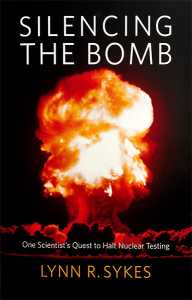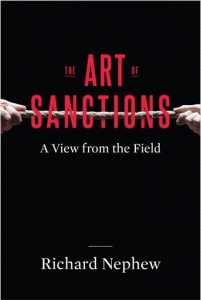BOOKS IN BRIEF: Silencing the Bomb, by Lynn R. Sykes; The Art of Sanctions, by Richard Nephew
Silencing the Bomb: One Scientist’s Quest to Halt Nuclear Testing
By Lynn R. Sykes, Columbia University Press, 2017, 284 pp.
 Lynn R. Sykes, a professor emeritus of earth and environmental sciences at Columbia University, was one of the scientists who adapted earthquake detection technologies for application to detection of explosive nuclear testing. This account of his work and his activist role in pushing for a ban on nuclear testing provides a unique historical view for those who wish to learn more about the intersection of science and treaty negotiation. Sykes’ experience shapes this historical overview of the negotiations to end nuclear testing, which produced the 1996 Comprehensive Test Ban Treaty (CTBT). He covers a period of time from the development of nuclear weapons in the 1940s to the advancement of nuclear test monitoring technologies, the 1963 Partial Test Ban Treaty, and the 1999 Senate rejection of the CTBT. Sykes then looks ahead at efforts to continue to push for ways to permanently prohibit nuclear testing.—SHERVIN TAHERAN
Lynn R. Sykes, a professor emeritus of earth and environmental sciences at Columbia University, was one of the scientists who adapted earthquake detection technologies for application to detection of explosive nuclear testing. This account of his work and his activist role in pushing for a ban on nuclear testing provides a unique historical view for those who wish to learn more about the intersection of science and treaty negotiation. Sykes’ experience shapes this historical overview of the negotiations to end nuclear testing, which produced the 1996 Comprehensive Test Ban Treaty (CTBT). He covers a period of time from the development of nuclear weapons in the 1940s to the advancement of nuclear test monitoring technologies, the 1963 Partial Test Ban Treaty, and the 1999 Senate rejection of the CTBT. Sykes then looks ahead at efforts to continue to push for ways to permanently prohibit nuclear testing.—SHERVIN TAHERAN
The Art of Sanctions: A View from the Field
By Richard Nephew, Columbia University Press, December 2017, 232 pp.
 Richard Nephew, senior research scholar and program director at Columbia University’s Center on Global Energy Policy, provides a practical framework for applying and evaluating the efficacy of sanctions. Nephew’s guidelines stress that the relationship between a target state’s ability to absorb pain and its resolve to overcome pain is the critical factor for assessing how a state will respond to sanctions pressure. Nephew argues that to use sanctions property, measures should be introduced incrementally and that the state being sanctioned must understand under what conditions that pressure will be eased or removed. He offers options for calibrating sanctions to be more effective and pairing sanctions with a diplomatic approach. Nephew draws on his experience at the U.S. Department of State as deputy coordinator for sanctions policy to provide anecdotes about the U.S. experience applying sanctions on Iran and Iraq, which help illustrate his framework and make for an entertaining read.
Richard Nephew, senior research scholar and program director at Columbia University’s Center on Global Energy Policy, provides a practical framework for applying and evaluating the efficacy of sanctions. Nephew’s guidelines stress that the relationship between a target state’s ability to absorb pain and its resolve to overcome pain is the critical factor for assessing how a state will respond to sanctions pressure. Nephew argues that to use sanctions property, measures should be introduced incrementally and that the state being sanctioned must understand under what conditions that pressure will be eased or removed. He offers options for calibrating sanctions to be more effective and pairing sanctions with a diplomatic approach. Nephew draws on his experience at the U.S. Department of State as deputy coordinator for sanctions policy to provide anecdotes about the U.S. experience applying sanctions on Iran and Iraq, which help illustrate his framework and make for an entertaining read.
—KELSEY DAVENPORT
